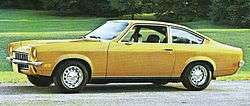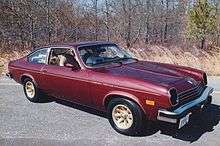Chevrolet Vega
| Chevrolet Vega | |
|---|---|
|
1971 Chevrolet Vega | |
| Overview | |
| Manufacturer | Chevrolet (General Motors) |
| Also called | Vega 2300 |
| Production | 1970–1977 |
| Model years | 1971–1977 |
| Assembly |
Lordstown Assembly, Lordstown, Ohio, United States South Gate Assembly South Gate, California, United States Sainte-Thérèse Assembly- Quebec, Canada |
| Designer |
GM & Chevrolet design staffs chief stylist, Bill Mitchell |
| Body and chassis | |
| Class | Subcompact |
| Body style |
2-door notchback sedan 2-door hatchback coupe 2-door wagon 2-door panel delivery |
| Layout | FR layout |
| Platform | GM H platform (RWD) |
| Related | Pontiac Astre, Chevrolet Monza, Pontiac Sunbird, Buick Skyhawk, Oldsmobile Starfire |
| Powertrain | |
| Engine |
140 cu in (2.3 L) GM 2300 OHC 1bbl I4 140 cu in (2.3 L) OHC 2bbl I4 122 cu in (2.0 L) DOHC EFI I4 |
| Transmission |
3-speed manual 4-speed manual 5-speed manual w/overdrive Torque-Drive clutchless manual 2-speed Powerglide automatic 3-speed Turbo-Hydramatic auto. |
| Dimensions | |
| Wheelbase | 97.0 in (2,464 mm) |
| Length | 169.7 in (4,310 mm) |
| Width | 65.4 in (1,661 mm) |
| Height | 51 in (1,295 mm) |
| Curb weight | 2,181–2,270 lb (989–1,030 kg) (1971) |
| Chronology | |
| Successor | Chevrolet Cavalier |
The Chevrolet Vega is a subcompact automobile that was produced by Chevrolet from 1970 to 1977. Available in two-door hatchback, notchback, wagon, and panel delivery body styles, all models were powered by an inline four-cylinder engine with a lightweight, aluminum alloy cylinder block. Variants included the Cosworth Vega, a short-lived limited-production performance model, introduced in March 1975.
The Vega received praise and awards at its introduction, including 1971 Motor Trend Car of the Year.[1] Subsequently the car became widely known for a range of problems related to its engineering,[2] reliability,[3] safety,[4][5] propensity to rust, and engine durability. Despite a series of recalls and design upgrades, the Vega's problems tarnished both its own as well as General Motors' reputation. Production ended with the 1977 model year.
The name "vega" derives from[6] the brightest star in the constellation Lyra. It forms one corner of the Summer Triangle.
History
Chevrolet and Pontiac divisions worked separately on small cars in the early and mid 1960s. Ed Cole, GM's executive vice-president of operating staffs, working on his own small-car project with corporate engineering and design staffs, presented the program to GM's president in 1967. GM chose Cole's version over proposals from Chevrolet and Pontiac, and gave the car to Chevrolet to sell. Corporate management made the decisions to enter the small car market and to develop the car itself.
In 1968, GM chairman James Roche announced GM would produce the new car in the U.S. in two years. Ed Cole was chief engineer and Bill Mitchell, vice-president of design staff, was chief stylist. Cole wanted a world-beater in showrooms in 24 months.[7] A GM design team was set up, headed by James G. Musser Jr. who had helped develop the Chevy II, the Camaro, the Chevrolet small-block V8 engines, and the Turbo-Hydramatic transmission. Musser said, "This was the first vehicle where one person was in charge," and that his team "did the entire vehicle."[7] As GM president, Cole oversaw the car's genesis and met the projected schedule.
Development 1968–1970
The Vega was conceived in 1968 to utilize newly developed all-aluminum die-cast engine block technology – the first sand-cast aluminum blocks had preceded the decision to build the car by two years. A relatively large displacement engine with good low- speed torque was decided on, with gear ratios for low engine rpm to achieve fuel economy. Engine testing totalled 6,000,000 miles. A pre-test engine was installed in a Fiat 124 sedan for development of the aluminum block, while several 1968 Opel sedans were used for drive train development[8]
Chevrolet instituted a new management program, the car line management technique, to produce the all-new car in two years. The chief vehicle engineer had overall charge of the program. Fifty engineers, dedicated to the design of the entire car, were divided into groups: body, power train, chassis design, product assurance, and pleasability. The latter would check continuously on the vehicles on the assembly line, with computers in another program monitoring quality control of every vehicle built.[8] Fisher Body engineers and draftsmen moved in with the Vega personnel.
In October 1968, there was one body style (the "11" style notchback sedan), one engine, one transmission (MB1 Torque-Drive manually shifted two-speed automatic), one base trim level, a bench seat, molded rubber floor covering, no glove box or headliner and no air-conditioning (ventilation was through the upper dash from the wiper plenum). As the market changed, so did the car in development.
In December 1968, hatchback, wagon, and panel delivery styles were added; also floor-level ventilation, and an optional performance engine ("L-11" two-barrel) which, predicted as 20% of production, accounted for 75%. Bucket seats were standard. Hatchback and wagon received carpeting and headliners. Optional air conditioning, predicted as 10% of production, rose to 45%.
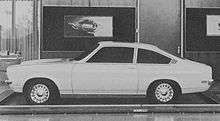
Chevrolet studio final design, 1969
In February 1969, Opel three- and four-speed transmissions (three-speed standard, others optional); Powerglide were added (now four transmissions); mechanical fuel pump replaced by in-tank electric pump; power steering option; base "11" style notchback trim upgraded to match hatchback and wagon carpet and headliner.
In April 1969, the car gained gauge-pack cluster, HD suspension, wider tires; adjustable seat back (45% of production); bumpers restyled, lower valance panels added; swing-out quarter window option (10% of production).
In July 1969, an electrically heated backlite option (10% of production); "GT" package, $325.00 extra (35% of production); bright window-frame and roof drip moldings added to hatchback and wagon.
This is essentially how the car launched as a 1971 model. Production began on June 26, 1970. After the national GM strike (September to November 1970), bright roof drip moldings were added to the base "11" notchback, with moldings sent to dealers to update units already in the field.
Cars magazine said in 1974 that in the rush to introduce the car with other 1971 models "[t]ests which should have been at the proving grounds were performed by customers, necessitating numerous piecemeal "fixes" by dealers. Chevrolet's "bright star" received an enduring black eye despite a continuing development program which eventually alleviated most of these initial shortcomings."[9]
Design and engineering

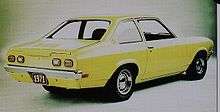
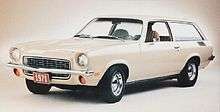
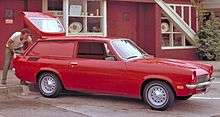
The wheelbase on all models is 97.0 inches (2,460 mm). Width is 65.4 inches (1,660 mm). The 1971 and 1972 models are 169.7 inches (4,310 mm) long. The 1973 models are 3 inches (76 mm) longer due to the front 5 mph bumper. Front and rear 5 mph bumpers on 1974 to 1977 models add another 5.7 inches (140 mm).
The hatchback coupe with its lower roofline and a fold-down rear seat accounted for nearly half of all Vegas sold.[10] The sedan, later named "notchback" is the only Vega model with an enclosed trunk, and had the lowest base price.[11]The Kammback wagon has a lower cargo liftover height and a swing-up liftgate.[11] The panel express panel delivery model has steel panels in place of the wagon's rear side glass, an enclosed storage area under the load floor, and a low-back driver's seat. An auxiliary passenger seat was optional.[12]
The aluminum-block inline-four engine was a joint effort by General Motors, Reynolds Metals, and Sealed Power Corp. The engine and its die-cast block technology were developed by GM engineering staff, then passed to Chevrolet for finalization and production. Ed Cole, involved with the 1955 small-block V8 as chief engineer at Chevrolet and now equally involved with the Vega engine as GM president, often visited the engineering staff engine drafting room on Saturdays, reviewing the design and directing changes, to the consternation of Chevrolet engineers and manufacturing personnel, who knew he wanted a rush job.[7] The engine in development became known in-house as "the world's tallest, smallest engine" due to the tall cylinder head.[13] Its vibration, noise, and tendency to overheat were rectified by 1974.[9]
The Vega’s suspension, live rear axle, 53.2% front/46.8% rear weight distribution, low center of mass and neutral steering give good handling. Lateral acceleration capacities are 0.90 g (standard suspension) and 0.93 g (RPO F-41 suspension). Steering box and linkage are ahead of the front wheel centerline, with a cushioned two-piece shaft. Front suspension is by short and long arms, with lower control arm bushings larger than on the 1970 Camaro.[14] Four-link rear suspension copies the 1970 Chevelle.[7] There are coil springs all around.[15]
The chassis development engineers aimed for full-size American car ride qualities with European handling. Later torque-arm rear suspension eliminated rear wheel hop under panic braking. Brakes (front discs, rear drums) copy an Opel design, with 10-inch (250 mm) diameter single-piston solid rotors, 9-inch (230 mm) drums and 70/30 front/rear braking distribution.[7]
All models share the same hood, fenders, floor pan, lower door panels, rocker panels, engine compartment and front end. In mid-1971, Chevrolet introduced an optional GT package for hatchback and Kammback models, which included the RPO L11 two-barrel 140 engine, F41 handling option, special tires and trim.
Model year changes
For 1972, models had a revised exhaust system and driveline to reduce vibration and noise; also revised shock absorbers. Turbo-hydramatic three-speed automatic transmission and custom cloth interior were optional and a glove box was added.[16]
For 1973, 300 changes included new exterior and interior colors and new standard interior trim. Front and rear nameplate scripts "Chevrolet Vega 2300" were changed to "Vega by Chevrolet". To meet the 1973 5 mph front bumper standards the front bumper, on stronger brackets, was extended 3 inches (76 mm), with a steel body-color filler panel. US-built Saginaw manual transmissions and a new shift linkage replaced the Opel units. The RPO L11 engine had a new Holley 5210C progressive two-barrel carburetor. New options included BR70-13 white-stripe steel-belted radial tires, full wheel covers, and body side molding with black rubber insert. Two new models were introduced mid-year: the estate wagon with DI-NOC wood grain sides and rear trim, and the LX notchback with vinyl roof finish. On May 17, 1973, the millionth Vega left the Lordstown Assembly plant – an orange GT hatchback with white sport stripes, power steering and neutral custom vinyl interior including exclusive vinyl door panels. A limited-edition "Millionth Vega" was introduced replicating the milestone car, with orange carpeting and Millionth Vega door handle accents. Sixty-five hundred were built from May 1 to July 1.[17]
For 1974, the major exterior changes were a revised front end and 5 mph rear bumper, increasing overall length 6 inches (150 mm),[18] and a slanted front header panel with recessed headlamp bezels. Louvered steel replaced the egg-crate plastic grille. Front and rear aluminum bumpers with inner steel spring replaced the chrome items, with license plate mountings relocated. A revised rear panel on notchback and hatchback models had larger single-unit taillights, with ventilation grills eliminated from trunk and hatch lids. A 16-US-gallon (61 l; 13 imp gal) fuel tank replaced the 11-US-gallon (42 l; 9.2 imp gal) tank. Side striping replaced the hood and deck stripes for the GT sport stripes option. The custom interior's wood-trimmed molded door panels were replaced by vinyl door panels matching the seat trim. January saw plastic front fender liners added after thousands of fenders were replaced under warranty on 1971–1974 models. In February the "Spirit of America" limited-edition hatchback was introduced, with white exterior, white vinyl roof, blue and red striping on body sides, hood and rear-end panel, emblems on front fenders and rear panel, white "GT" wheels, A70-13 raised white-letter tires, white custom vinyl interior and red accent color carpeting.[19] Seventy-five hundred Vegas were built through May. Sales peaked at 460,374 for the 1974 model year.[10]
The 264 changes for 1975 included H.E.I. (high-energy) electronic ignition and a catalytic converter. New options included power brakes, tilt steering wheel, BR78-13B steel belted radial tires, and special custom cloth interior for the hatchback and Kammback. In March the Cosworth Vega was introduced with an all-aluminum engine and electronic fuel injection, the first on a Chevrolet passenger car.[20] The panel express was discontinued at the end of the model year. Its sales peaked at 7,800 in its first year, then averaged 4,000 per year. Over 1,500 1975 models were sold.[21] Total sales fell to 206,239.
For 1976, models had 300 changes. A facelift included revised header panel with Chevy bowtie emblem, wider grill, revised headlamp bezels – all in corrosion-resistant material – and new tri-color taillights for the notchback and hatchback (although the amber turn signals were nonfunctional). Cooling and durability of the Dura-Built 2.3-liter engine were improved. The chassis received the Monza's upgraded components including box-section front cross-member, larger front and rear brakes (with the fronts gaining vented rotors), and torque-arm rear suspension. Extensive anti-rust improvements to the body included galvanized fenders and rocker panels. New models were introduced: GT estate wagon, Cabriolet notchback (with a half-vinyl roof and opera windows similar to the Monza Towne coupe) and limited-edition Nomad wagon with restyled side windows.[22] New options included BorgWarner five-speed manual overdrive transmission and houndstooth seat trim named "sport cloth" at an additional $18. A "Sky-Roof" with tinted reflecting sliding glass and an eight-track tape player were options from January. The Cosworth was canceled in July after 1,446 1976 models.[23]
For 1977, models had few revisions. The notchback was renamed "coupe". On the Dura-built 140 engine a pulse-air system met stricter Federal emission standards. The single-barrel engine and three-speed manual transmission were dropped. Interiors received color-keyed steering column, steering wheel, instrument cluster face and parking brake cover, with color-keyed full console a new option. GTs received black exterior moldings (lower moldings deleted), black sport mirrors and wheels, bold Vega GT side striping and rear Vega GT ID[24]
Engine

The Vega engine is a 2,287 cc (2.3 L; 139.6 cu in) inline-four with a die-cast aluminum alloy cylinder block, cast-iron cylinder head and single overhead camshaft (SOHC).[25] The block is an open-deck design with siamesed cylinder bores. The outer case walls form the water jacket, sealed off by the head and head gasket, and the block has cast-iron main caps and crankshaft. The cast-iron cylinder head was chosen for low cost. A simple overhead valvetrain has three components activating each valve instead of a typical pushrod system's seven. An external belt from the crankshaft drives the five-bearing camshaft plus the water pump and fan.[26]
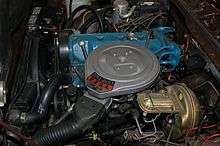
Compression ratio for the standard and optional engine is 8.0:1, as the engine was designed for low-lead and lead-free fuels. The single-barrel carburetor version produces 90 hp (67 kW); the two-barrel version (RPO L11) produces 110 hp (82 kW). From 1972, ratings were listed as SAE net. The engine is prone to vibration, which is damped by large rubber engine mounts. The 1972 Rochester DualJet two-barrel carburetor required an air pump for emission certification and was replaced in 1973 with a Holley-built 5210C progressive two-barrel carburetor. The 1973 emission control revisions reduced power from the optional engine by 5 bhp (3.7 kW), and its noise levels were lowered.[27] A high energy ignition ignition was introduced on 1975 engines.[28]
Serious problems with the engine led to a redesign for 1976–1977. Marketed as the Dura-Built 140, the new engine had improved coolant pathways, redesigned cylinder head with quieter hydraulic valve lifters, longer-life valve stem seals that reduced oil consumption by 50%, and redesigned water pump, head gasket, and thermostat. Warranty was upgraded to five years or 60,000 miles (97,000 km).[29] In 1977 a pulse-air system was added to meet stricter 1977 U.S. exhaust emission regulations and the engine paint color (used on all Chevrolet engines) changed from orange to blue.
In August 1975, Chevrolet conducted an endurance test of three Vegas powered by Dura-Built engines, advertised as a "60,000 miles in 60 days Durability Run".[30] Supervised by the United States Auto Club, three pre-production 1976 hatchback coupes with manual transmissions and air conditioning were driven non-stop for 60,000 miles (97,000 km) in 60 days through the deserts of California and Nevada by nine drivers, covering a total of 180,000 miles (290,000 km). With the sole failure a broken timing belt, Vega project engineer Bernie Ernest said GM felt “very comfortable with the warranty."[31]
Motor Trend said "Chevrolet chose the 349-mile Southwestern desert route in order to show the severely criticized engine and cooling system had been improved in the 1976 model." In ambient temperatures between 99 °F (37 °C) and 122 °F (50 °C) the cars lost 24 US fluid ounces (0.71 L) of coolant (normal evaporation under the conditions) during the 180,000 miles. They averaged 28.9 mpg-US (8.1 L/100 km; 34.7 mpg-imp) and used one quart of oil per 3,400 miles. Driving expenses averaged 2.17 cents per mile.[31] One of the cars went on display at the 1976 New York Auto Show. The 1976 Vega was marketed as a durable and reliable car.[32][33]
Engine output summary
| Year | Standard engine | Optional L-11 engine & GT (Z29) | Cosworth twin-cam (ZO9) |
|---|---|---|---|
| 1971 | 90 hp (67 kW) @ 4,400 rpm 136 lb·ft (184 N·m) @ 2,400 rpm |
110 hp (82 kW) @ 4,800 rpm 138 lb·ft (187 N·m) @ 3,200 rpm |
|
| 1972 | 80 hp (60 kW) @ 4,400 rpm 121 lb·ft (164 N·m) @ 2,400 rpm |
90 hp (67 kW) @ 4,800 rpm 121 lb·ft (164 N·m) @ 2,800 rpm |
|
| 1973 | 72 hp (54 kW) @ 4,400 rpm 100 lb·ft (136 N·m) @ 2,000 rpm |
85 hp (63 kW) @ 4,800 rpm 115 lb·ft (156 N·m) @ 2,400 rpm |
|
| 1974 | 75 hp (56 kW) @ 4,400 rpm 115 lb·ft (156 N·m) @ 2,400 rpm |
85 hp (63 kW) @ 4,400 rpm 122 lb·ft (165 N·m) @ 2,400 rpm |
|
| 1975 | 78 hp (58 kW) @ 4,200 rpm 120 lb·ft (163 N·m) @ 2,000 rpm |
87 hp (65 kW) @ 4,400 rpm 122 lb·ft (165 N·m) @ 2,800 rpm |
110 hp (82 kW) @ 5,600 rpm
107 lb·ft (145 N·m) @ 4,800 rpm |
| 1976 | 70 hp (52 kW) @ 4,200 rpm 120 lb·ft (163 N·m) @ 2,000 rpm |
84 hp (63 kW) @ 4,400 rpm 122 lb·ft (165 N·m) @ 2,800 rpm |
110 hp (82 kW) @ 5,600 rpm 107 lb·ft (145 N·m) @ 4,800 rpm |
| 1977 | 84 hp (63 kW) @ 4,400 rpm 122 lb·ft (165 N·m) @ 2,800 rpm |
notes: 1972–1977 hp/torque ratings are SAE net[34] L-11 engine standard on 1977 models[35]
Stillborn engines
OHC L-10
The optional L-11 engine was part of the Vega development program from December 1968, initially with a tall iron cylinder head that had an unusual tappet arrangement and side-flow combustion chambers. The Chevrolet engine group then designed an aluminum crossflow cylinder head with single central overhead camshaft, “hemi" combustion chambers and big valves. This was lighter and about 4" lower than the Vega production head. Although numerous prototypes were built and manufacturing tooling started, the engine did not receive production approval. It would have given higher performance than the iron-head engine, without its differential expansion head gasket problems.[13]
RC2-206 Wankel
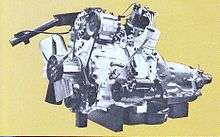
In November 1970, GM paid $50 million for initial licenses to produce the Wankel rotary engine. GM president Ed Cole projected its release in October 1973 as a 1974 Vega option. The General Motors Rotary Combustion Engine (GMRCE) had two rotors displacing 206 cu in (3,376 cc), twin distributors and coils, and an aluminum housing.[36] RC2-206 Wankels were installed in 1973 Vegas for cold weather testing in Canada.
Motor Trend's 1973 article The '75 Vega Rotary said: "[M]ileage will be in the 16–18 mpg range. Compared to the normal piston [engine] Vega's 20 to 26 mpg, the whole rotary deal begins to look just a little less attractive, what with the price of gasoline skyrocketing..."[37]
GM thought it could meet 1975 emissions standards with the engine tuned for better fuel economy. Other refinements improved it to 20 mpg-US (12 L/100 km; 24 mpg-imp), but brought apex seal failures and rotor-tip seal problems.[36] By December 1973 it was clear the Wankel, now planned for the Monza 2+2, would not be ready for either production or emissions certification in time for the start of the 1975 model year. After paying another $10 million against its rotary licence fees, GM announced the first postponement. In April 1974 Motor Trend predicted the final outcome:[38] on September 24, 1974, Cole postponed the engine, ostensibly due to emissions difficulties. He retired the same month. His successor Pete Estes showed little interest in the engine and GM, citing poor fuel economy, postponed production pending further development.[39]
V8
In July 1972, Hot Rod tested a prototype Vega fitted with an all-aluminum V8, the last of several 283 cu in (4.6 L) units used in the CERV I research and development vehicle. Bored out to 302 cu in (4.9 L), it had high-compression pistons, "097 Duntov" mechanical camshaft, cast-iron four-barrel intake manifold and a Quadrajet carburetor. With stock Turbo Hydramatic, stock Vega rear end and street tires, the car ran a sub-14 second quarter mile.[40]
Assembly
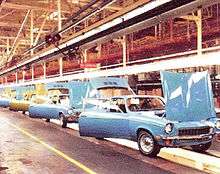
GM built the $75 million Lordstown Assembly plant in Lordstown, Ohio near Youngstown to make the Vega. It was the world's most automated auto plant,[7] where approximately 95 percent of each Vega body's 3,900 welds were carried out automatically by Unimate industrial robots. Engine and rear axle assemblies positioned by hydraulic lifts with bodies overhead moved along the line at 30 feet (9.1 m) per minute. Sub-assembly areas, conveyor belts and quality control were all computer directed.[41]
Production speed
Production at Lordstown was projected at 100 Vegas an hour—one every 36 seconds—from the outset. Twice the normal volume, this was the fastest rate in the world. Within months Lordstown produced 73.5 Vegas an hour.[7]
Lordstown workers had 36 seconds to perform their tasks instead of the customary minute. With 25 percent more line workers than needed, they formed groups in which three worked while a fourth rested. Although there were mechanical flaws, the quality of early Vega assembly, e.g. fit and finish, was acceptable. The car earned Motor Trend's 1971 Car of the Year award. In October 1971, General Motors handed management of Lordstown from Chevrolet and Fisher Body to General Motors Assembly Division (GMAD). GMAD imposed more rigorous discipline and cut costs by dropping the fourth "extra" worker. The United Auto Workers (UAW) said 800 workers were laid off at Lordstown in the first year under GMAD; GMAD said 370. Management accused workers of slowing the line and sabotaging cars by omitting parts and doing shoddy work. Workers said GMAD sped up the line and cut staffing. Quality suffered. In March 1972, the 7,700 workers called a wildcat strike that lasted a month and cost GM $150 million.[7] Vega production rose by over 100,000 units for 1972, and would have been stronger but for the strike. 1975 was a "rolling model change" at 100 cars per hour with no downtime.[7]
As production approached 100 vehicles per hour problems arose in the paint shop. At 85 units per hour, nearly all required repair. Conventional pressures and tips could not apply the paint fast enough; increasing pressures and tip apertures produced runs and sags. Fisher Body and lacquer paint supplier DuPont, over one weekend, developed new paint chemistry and application specifics: Non-Aqueous Dispersion Lacquer (NAD). The new formulation raised paint shop throughput to 106 units per hour.
Vertical rail transport

Although Lordstown Assembly had a purpose-built exit off of the Ohio Turnpike built to make shipment easier, the Vega was designed for vertical shipment, nose down. General Motors and Southern Pacific designed "Vert-A-Pac" rail cars to hold 30 Vegas each, compared with conventional tri-level autoracks which held 18. The Vega was fitted with four removable cast-steel sockets on the underside and had plastic spacers—removed at unloading—to protect engine and transmission mounts. The rail car ramp/doors were opened and closed via forklift.[42]
Vibration and low-speed crash tests ensured the cars would not shift or suffer damage in transit. The Vega was delivered topped with fluids, ready to drive to dealerships, so the engine was baffled to prevent oil entering the number one cylinder; the battery filler caps high on the rear edge of the casing prevented acid spills; a tube drained fuel from carburetor to vapor canister; and the windshield washer bottle stood at 45 degrees.[43]
Production figures
Total Vega production, mainly from Lordstown, was 2,006,661 including 3,508 Cosworth models.[44] Production peaked at 2,400 units per day. In 1973–1974, Vegas were also built at GM of Canada's Sainte-Thérèse Assembly plant in Quebec.

| Year | Notchback | Hatchback | Kammback | Panel del. | Cosworth | Total |
|---|---|---|---|---|---|---|
| 1971 | 58,804 | 168,308 | 42,793 | 7,800 | — | 277,705 |
| 1972 | 55,839 | 262,682 | 71,957 | 4,114 | — | 394,592 |
| 1973 | 58,425 | 266,124 | 102,751 | n/a | — | 427,300 |
| 1974 | 64,720 | 276,028 | 115,337 | 4,289 | — | 460,374 |
| 1975 | 35,133 | 112,912 | 56,133 | 1,525 | 2,061 | 207,764 |
| 1976 | 27,619 | 77,409 | 54,049 | — | 1,447 | 160,524 |
| 1977 | 12,365 | 37,395 | 25,181 | — | — | 78,402 |
| 2,006,661 |
Note: Does not include an unknown number of 1973 panel deliveries.
Pricing
Due mostly to inflation, but also because of emissions and safety mandates, prices of all automobiles rose 50 percent during the Vega's seven-year lifespan. The same basic Vega that cost $2090 in 1971 carried a retail price of $3249 by the end of 1977. And since all other cars suffered the same inflationary rise, less expensive cars were in greater demand than those with higher prices which helped Vegas sell. The 1975 Cosworth Vega at $5,918 was priced $892 below the Chevrolet Corvette. "Cosworth. One Vega for the price of two" as it was advertised, was priced out of the market, and fell well short of its projected sales goal.[45]
DeLorean influence
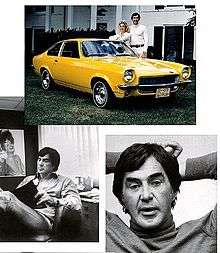
GM Vice President John Z. DeLorean, appointed Chevrolet’s general manager a year before the Vega's introduction, oversaw the Vega launch, directing the Chevrolet division and the Lordstown Assembly plant. He put additional inspectors and workers on the line and introduced a computerized quality control program in which each car was inspected as it came off the line and, if necessary, repaired.[46] He promoted the car in Motor Trend and Look magazines. He also authorized the Cosworth Vega prototype, and requested initiation of production.[47]
In Motor Trend's August 1970 issue, DeLorean promoted the upcoming car as one that out-handled “almost any” European sports car, out-accelerated “any car in its price class”, and would be “built at a quality level that has never been attained before in a manufacturing operation in this country, and probably in the world."[48]
In the 1979 book On a Clear Day You Can See General Motors - John Z. DeLorean's Look Inside The Automotive Giant by J. Patrick Wright, DeLorean spoke of hostility between Chevrolet Division and GM’s design and engineering staff; of trying to motivate the division to finesse the car before introduction; and of initiating quality control to make the cars the best quality ever built. "While I was convinced that we were doing our best with the car that was given to us, I was called upon by the corporation to tout the car far beyond my personal convictions about it."[46]
Problems
Although the Vega sold well from the beginning, the buying public soon questioned the car's quality. In Comeback:The Fall & Rise of the American Automobile Industry, the authors write: "In 1972, GM issued three mass recalls, the largest covering 500,000 Vegas, to fix defective axles, balky throttles and problems that caused fires. The Vega's aluminum engine was notorious for buckling and leaking."[49] Development and upgrades continued throughout the car's seven-year production run, addressing its engine and cost-related issues.[50]
Fisher Body
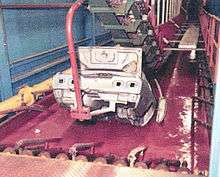
After a six-stage zinc phosphate rustproofing process and two minutes submerged in a 65,000 US gallons (246,052 L; 54,124 imp gal) electrophoretic painting vat (Fisher Body Division’s "Elpo" electrophoretic deposition of polymers process) to prime and further protect them from rust, assembled bodies were dried, wet-sanded, sealer-coated, sprayed with acrylic lacquer and baked in a 300 °F (149 °C) degree oven. Fisher's rustproofing was faulty. Failure to penetrate a gap between front fenders and cowl allowed moist debris and salt to rust the untreated steel, and trapped air prevented coating inside the tops of the front fenders, which on early Vegas had no protective liners.[7] The finance department had rejected liners as they would have added a $2.28 unit cost. After GM spent millions replacing thousands of corroded fenders under warranty, Chevrolet installed stopgap plastic deflectors in late 1973 and full plastic liners in 1974. Rust also damaged the rocker panels and door bottoms, the area beneath the windshield, and the body above the rockers. It sometimes seized the front suspension cam bolts, preventing alignment work, necessitating removal with a cutting torch and replacement by all-new parts.[13]
From 1976, anti-rust improvements included galvanized steel fenders and rocker panels; "four layer" fender protection with zinc coated and primed inner fenders; wheel-well protective mastic; zinc-rich pre-prime coating on inner doors; expandable sealer between rear quarter panel and wheel housing panel; and corrosion-resistant grill and headlamp housings.[7]
140 CID engine
Early Vega models were subject to two recalls. The first addressed backfiring on 130,000 cars fitted with L-11 option two-barrel carburetor, due to engine vibration loosening screws on the carburetor and causing over-fueling. The second, in the early summer of 1972, concerned a perceived risk that a component in the emission control system of 350,000 cars with the standard engine might fall into the throttle linkage, jamming it open.[51] Faulty valve-stem seals caused excessive oil consumption,[7] but this was not addressed until the release of the updated Dura-built engine in 1976.[52]
With its small 6 US quarts (5.7 l) capacity and tiny two-tube 1 sq ft (0.1 m2) radiator, the Vega cooling system was adequate when topped off,[53] but owners tended not to check the coolant level often enough, and in combination with leaking valve-stem seals the engine often ran low on oil and coolant simultaneously. Consequent overheating distorted the open deck block, allowing antifreeze to seep past the head gasket, which caused piston scuffing inside the cylinders.[7]
Chevrolet added a coolant overflow bottle and an electronic low-coolant indicator in 1974 that could be retrofitted to earlier models at no cost. Under a revised 50,000-mile (80,000 km) engine warranty for 1971 to 1975 Vegas, the owner of a damaged engine could choose replacement with a new short block or a rebuilt steel-sleeved unit, which proved costly for Chevrolet. GM engineer Fred Kneisler maintains that too much emphasis had been put on overheating problems, the real culprits being brittle valve stem seals and too-thin piston plating. Regardless of the cause, damaged cylinder walls were common.
The 1976 to 1977 Dura-Built 140 engine had improved engine block coolant pathways, redesigned head gasket, water pump and thermostat, and a five-year/60,000 mi (97,000 km) warranty.[52]
Reception
Initially the Vega received awards and praise, but subsequently there were lasting criticisms.
The Vega received awards including "1971 car of the year"[54] and "1973 car of the year in the economy class";[55] from Motor Trend; "best economy sedan" in 1971, 1972 and 1973 from Car and Driver;[56] and the 1971 award for "excellence in design in transportation equipment" from American Iron and Steel Institute.[57]
Favorable reviews at launch included Motor Trend which in 1970 described the Vega as enjoyable, functional, comfortable, with good handling, and ride;[15] Road and Track who praised its visibility, freeway cruising and economy.[58] and others who praised the 2300 engine's simplicity,[59] the handling package and brakes,[60] and one said the car was well matched to the tastes and needs of the 1970s,[61] Others praised its looks.[62][63][64] Comparisons with other contemporary cars such as the Ford Pinto, Volkswagen Beetle, AMC Gremlin, and Toyota Corolla were done by a number of magazines. The Vega came out well, scoring praise for its combination of performance and economy";[65][66] as well as its speed, comfort, quietness and better ride.[67] Road and Track's editor, John R. Bond said in September 1970, "I think the Vega is beyond a doubt the best handling passenger car ever built in the U.S. It has many other good qualities, but the roadholding impressed and surprised me most of all."[68]
The Center for Auto Safety criticized the car. A letter from its founder Ralph Nader to GM chairman Richard Gerstenberg contained a list of safety allegations, and said the car was a "sloppily crafted, unreliable and unsafe automobile" that "hardly set a good example in small car production for American industry".[69] Criticisms continued long after production ceased. In 1979, Popular Science said free repairs in the 1970s cost tens of millions, continuing up to two years after the warranty ran out.[70] A 1990 Time article said the Vega was "a poorly engineered car notorious for rust and breakdowns."[71][72] In 1991, Newsweek magazine called the Vega costlier and more troublesome than its rivals.[73]
Joe Sherman's 1993 book In the Rings of Saturn said that "by its third recall, ninety-five percent of all Vegas manufactured before May 1972 had critical safety flaws", and that the model's "checkered history only reinforced the belief that GM made inferior small cars. This legacy would prove far more important than any direct impact the Vega would have on GM's profits."[74] Motor Trend said in its September 1999 50th Anniversary Issue: "The Vega seemed well placed to set the standard for subcompacts in the 70s, but it was troubled by one of the most vulnerable Achilles heels in modern automotive history; an alloy four-cylinder engine block that self-destructed all too easily, and all too often. Once the word got out the damage was done, even though the engine had been revamped."[75] The April 2000 issue of Collectible Automobile magazine said: "The Chevy Vega has become a symbol of all the problems Detroit faced in the 70's."[76] Robert Freeland's 2005 book The Struggle for Control of the Modern Corporation said "poor planning and perfunctory implementation ... led to an extremely poor quality automobile beset by mechanical problems,"[77] In his 2010 book Generation Busted, author Alan Zemek said, "Chevrolet's answer to the Japanese car, left it with a black eye."[78]
Websites have included the Vega in lists of worst cars, for example Popular Mechanics,[79] Car and Driver,[80] and Edmunds.com.[81] In 2010, John Pearley Huffman of Popular Mechanics summed up the Vega as "the car that nearly destroyed GM."[3]In 2010, after driving a preserved, original '73 Vega GT, Frank Markus of Motor Trend Classic said, "After a few gentle miles, I begin to understand how this car won its awards and comparison tests. Well-maintained examples are great looking, nice-driving, economical classics—like Baltic Ave. with a Hotel, the best ones can be had for $10K or less."[82] In 2013, Frank Markus of Motor Trend Classic said, "Overblown - The China Syndrome might have overhyped the TMI (Three-Mile Island) incident as bad press might have exaggerated the Vega's woes."[83]
Rebadged variants
Vega body styles were used for several badge engineered variants. The 1973 to 1977 Pontiac Astre had Vega bodies (and Vega engines through 1976). The 1978 to 1979 Chevrolet Monza and Pontiac Sunbird wagons used the Vega Kammback wagon body with engines by Pontiac and Buick. The Monza S used the Vega hatchback body.[84]
XP-898 concept
In 1973, Chevrolet presented the XP-898 concept car using many Vega components, including the engine, and using a construction method intended to explore vehicle crashworthiness at high speed: a fiberglass foam sandwich body and chassis in four sections with rigid urethane foam infill.[85]
Motorsport
Car and Driver's showroom stock No. 0
In the early 1970s Car and Driver magazine challenged its readers to a series of Sports Car Club of America (SCCA) races for showroom stock sedans at Lime Rock Park, Connecticut - "The Car and Driver SS/Sedan Challenge". Bruce Cargill (representing the readers) won "Challenge I" in 1972 in a Dodge Colt, and Patrick Bedard, C&D's executive writer, won "Challenge II" in 1973 in an Opel 1900, "Challenge III" was the tie-breaker in 1974.
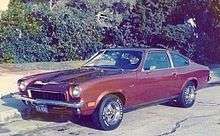
On October 12, 1974 C&D's 1973 Vega GT No. 0, driven by Bedard, "outran every single Opel, Colt, Pinto, Datsun, Toyota and Subaru on the starting grid [...] It had done the job - this Vega GT faced off against 31 other well-driven showroom stocks and it had finished first.[86]
After Bedard purchased the year-old Vega in California for $1,900, former Chevrolet engineer Doug Roe -- a Vega specialist -- told him to "overfill it about a quart. "When you run them over 5,000 rpm, all the oil stays up in the head and you'll wipe the bearings. And something has to be done with the crankcase vents. If you don't it'll pump all that oil into the intake." Roe added that 215 degrees was normal and only above 230 degrees would the engine probably" detonate.
Bedard said, "Five laps from the end I discovered that once the tank drops below a quarter full, the fuel wouldn't pick up in the right turns. Twice per lap the carburetor would momentarily run dry. And if that wasn't bad enough, the temperature gauge read exactly 230 degrees and a white Opel was on my tail as unshakably as a heat-seeking missile. But it was also clear that no matter how good a driver Don Knowles was and no matter how quick his Opel, he wasn't going to get by if the Vega simply stayed alive. Which it did. You have to admire a car like that. If it wins, it must be the best, never mind all of the horror stories you hear, some of them from me."[86]
References
- ↑ Motor Trend-February 1971. 1971 Car of The Year: Chevrolet Vega 2300
- ↑ "The Right Stuff: Does U.S. Industry Have It?". Time. October 29, 1990. Retrieved 2012-01-13.
The bad reputation spread in 1970 with the Chevrolet Vega, a poorly engineered car notorious for rust and breakdowns.
- 1 2 Huffman, John Pearley (2010-10-19). "How the Chevy Vega Nearly Destroyed GM". Popular Mechanics. Retrieved 2011-12-17.
- ↑ "AUTOS: Too Small, Too Soon". Time. November 29, 1971. Retrieved 2012-01-13.
Films of those tests were shown at a Washington press conference last week by Institute President William Haddon Jr., former director of the National Highway Safety program. They might badly shake many buyers of small new cars, which now account for one-third of sales. In some crashes, the small car was smashed into a pile of twisted junk barely recognizable as an auto, while the bigger car sustained relatively moderate damage. In the Chevrolet crash, a dummy placed in the Impala only struck its head against the dashboard, but the dummy in the Vega was beheaded by a section of the hood that was hurled back through the windshield.
- ↑ Sherman, Joe (1993). In the Rings of Saturn. Oxford University Press. p. 70. ISBN 978-0-19-507244-0. Retrieved 2012-01-13.
- ↑ LIFE magazine, August 7, 1970, "Twinkle twinkle little car", p. 11.
- 1 2 3 4 5 6 7 8 9 10 11 12 13 Collectible Automobile-April 2000
- 1 2 Motor Trend, February 1971 "Chevrolet Vega 2300 Car of the Year-Engineering".
- 1 2 Cars magazine April 1974
- 1 2 Gunnell, John, ed. (1987). The Standard Catalog of American Cars, 1946–1975. Krause Publications. ISBN 978-0-87341-096-0.
- 1 2 1973 Chevrolet Vega brochure
- ↑ 1971 Chevrolet Trucks full-line brochure.
- 1 2 3 Hinckley, John (1st Qtr. 2002). "Little-known Vega Development stories". Cosworth Vega Magazine (80): 1. Check date values in:
|date=(help) - ↑ Chevrolet Vega engineering report – 1970
- 1 2 Motor Trend August 1970.
- ↑ 1972 Chevrolet Vega brochure.
- ↑ Chevrolet press release, May 17, 1973.
- ↑ 1974 Chevrolet Vega brochure.
- ↑ 1974 Chevrolet Folder-Spirit of America Vega.
- ↑ GM Heritage Center, Generations of GM History
- ↑ H Body.org FAQ
- ↑ 1976 Vega brochure
- ↑ Chevrolet Division memo, July 1976.
- ↑ 1977 Chevrolet Vega brochure.
- ↑ Quattroruote: Tutte le Auto del Mondo 74/75 (in Italian). Milano: Editoriale Domus S.p.A. 1974. pp. 107–110.
- ↑ Engineering Concept, Design and Development of Chevrolet's new little car Vega 2300.
- ↑ Road & Track, June 1973.
- ↑ 1975 Chevrolet Vega brochure.
- ↑ 1976 Chevrolet Vega brochure
- ↑ Quoted text-Chevrolet brochure-60,000 miles in less than 60 days in and around Death Valley. '76 Vega Dura-Built engine. Built to take it.
- 1 2 Motor Trend "The 60,000-mile Vega" February 1976, p. 24, quote.
- ↑ 1976 Chevrolet Brochure-'76 Vega Dura-built engine. Built to take it.
- ↑ 1976 Chevrolet Vega ad-Built to take it.
- ↑ 1971–1977 Chevrolet Vega brochures - engine hp/torque specifications
- ↑ 1977 Vega brochure
- 1 2 Motor Trend, July 1973, p. 52.
- ↑ quote: Motor Trend, July 1973, p. 52.
- ↑ Motor Trend, April 1974.
- ↑ Estes had previously decided to let the Corvair, another Cole project, expire, well before the celebrated attacks of Ralph Nader. Motor Trend, April 1974.
- ↑ Hot Rod, July 1972.
- ↑ Motor Trend, February 1971.
- ↑ Popular Mechanics, October 1969, p. 151.
- ↑ Collectible Automobile. April 2000 p. 37 "Riding the rails: Shipping Vegas by Vert-a-pac."
- ↑ Collectible Automobile April 2000 p.43
- ↑ Collectible Automobile April 2000
- 1 2 Wright, J. Patrick (1979). On a Clear Day you Can See General Motors: John Z. DeLorean's Look Inside the Automotive Giant. Wright Enterprises. ISBN 978-0-9603562-0-1.
- ↑ Car and Driver, "How To Hatch an Engine", October 1975.
- ↑ quoted from Motor Trend, August 1970.
- ↑ Paul Ingrassia; Joseph B. White (1995). Comeback: The Fall & Rise of the American Automobile Industry. Simon & Schuster. ISBN 0684804379. Retrieved July 8, 2012.
- ↑ Collectible Automobile, April 2000.
- ↑ Schwartzberg, Bill (July 1972). "Report from America". Safer Motoring: 368.
- 1 2 1976 Chevrolet brochure-Vega Dura-built engine-built to take it
- ↑ Collectible Automobile, April 2000, interview Eudell Jackobson & Fred Kneisler of GM engineering.
- ↑ Motor Trend, February 1971. "1971 Car of The Year: Chevrolet Vega 2300."
- ↑ Motor Trend, February 1973. "The Car of the Year Candidates"
- ↑ Car and Driver, May 1971, May 1972, May 1973
- ↑ 1973 Chevrolet folder: back cover-Best Economy Sedan for '73-Vega.
- ↑ Road and Track, September 1970. pp.31–34
- ↑ quoted from: Sports Car Graphic, September 1970.
- ↑ Road Test, November 1970, p. 53.
- ↑ Quote, Super Stock, October 1970, p. 80.
- ↑ Car and Driver, December 1971, "Super Coupe Comparison Test" p. 25.
- ↑ Car and Driver 1972 Buyer's Guide
- ↑ "Chevrolet Vega vs. Ford Pinto". Car and Driver. November 1971. Retrieved 2011-12-17.
- ↑ Car and Driver, January 1971. "Six-Car Comparison Test." p. 21.
- ↑ Motor Trend, January 1972, "A Back Door To Economy."
- ↑ Motor Trend, January 1971.
- ↑ Road & Track Sept. 1970
- ↑ Kimes & Ackerson, p. 157.
- ↑ Dunne, Jim (May 1979). "Secret car warranties". Popular Science: 58–60. Retrieved 2011-12-15.
- ↑ "The Right Stuff: Does U.S. Industry Have It?". Time Magazine. 1990-10-29. Retrieved 2011-12-15.
The bad reputation spread in 1970 with the Chevrolet Vega, a poorly engineered car notorious for rust and breakdowns.
- ↑ "Autos: Too Small, Too Soon". Time. 1976-04-05. Retrieved 2011-12-15.
- ↑ "GM's Day Of Reckoning". Newsweek. 1991-12-30. Retrieved 2011-12-15.
- ↑ Sherman, Joe (1994). In the rings of Saturn. Oxford University Press. p. 70. ISBN 978-0-19-507244-0. Retrieved 2011-12-16.
- ↑ Quote, Motor Trend, September 1999, Motor Trend 50th Anniversary Issue
- ↑ Collectible Automobile, April 2000 p. 26.
- ↑ Freeland, Robert F. (2000). The Struggle for Control of the Modern Corporation. Cambridge University Press. p. 288. ISBN 978-0-521-63034-4. Retrieved 2011-12-17.
- ↑ Zemek, Alan J. (2010). Generation Busted: How America Went Broke in the Age of Prosperity. CreateSpace. p. 122. ISBN 978-1-4515-1686-9. Retrieved 2011-12-17.
- ↑ Huffman, John Pearley (2008-11-24). "10 Cars that Damaged GM's Reputation". Popular Mechanics. Retrieved 2011-12-17.
- ↑ "Dishonorable Mention: The 10 Most Embarrassing Award Winners in Automotive History". Car and Driver. January 2009. Retrieved 2011-12-17.
- ↑ Huffman, John Pearley (2011-12-12). "100 Worst Cars of All Time". Edmunds.com. Retrieved 2011-12-17.
- ↑ Motor Trend Classic, Spring 2010
- ↑ Motor Trend Classic, Fall 2013
- ↑ 1973–1977 Pontiac Astre brochures, 1978–1979 Chevrolet Monza brochures, 1978–1979 Pontiac Sunbird brochures.
- ↑ Bowman, Bill. "1973 Chevrolet XP-898 Concept Car". General Motors Heritage Center. Retrieved 2012-01-13.
- 1 2 Car and Driver, January 1975. "An unlikely victory in an even more unlikely car."
Bibliography
- Kimes, Beverly Rae; Ackerson, Robert C. (1987). Chevrolet: A History from 1911. Automobile Heritage Publishing. ISBN 978-0-915038-62-6.
External links
- Hemmings Classic Car March 2014 - 1973 & '76 Chevrolet Vega Comparison
- Motor Trend Classic Spring 2013 - Chevrolet Cosworth Vega vs Mercury Capri II
- Motor Trend.com Fall 2010–1971 AMC Gremlin X, 1973 Chevrolet Vega GT, and 1972 Ford Pinto
- Car and Driver.com Archived Comparison - Chevrolet Vega vs Ford Pinto
- https://www.facebook.com/groups/VegaNation/
| Wikimedia Commons has media related to Chevrolet Vega. |
- Chevrolet Vega at DMOZ
- Chevrolet Vega at the Internet Movie Cars Database
